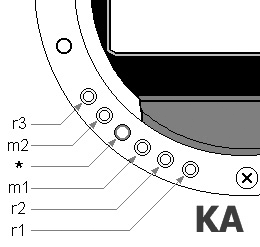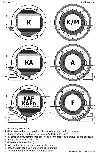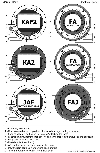Examination of Pentax K-mount variations and current compatibility problems
Update: with *istD firmware 1.10 or higher, the *istD is now capable of doing stop-down metering at all apertures with K- and M-series lenses too! So older lenses can be used on Pentax digital SLRSLR
Acronym of "Single Lens Reflex". See also "Reflex"'s now, including the *istDs (provided that you set the proper menu item). Very good!
Lately Pentax introduced some lenses without an aperture ring, suitable for their low-end cameras but not fully compatible with current midrange and top level models. This caused so much concern among Pentax users about a possible end of acclaimed Pentax compatibility, also considering the "simplified" bayonet introduced some years ago on a few budget models. In order to understand what is going on, here follows a technical overview of the variations of Pentax K bayonet from 1975 to date, and an investigation about the limitations when using either a camera or a lens with "crippled" mounts.
1975: K
The original K bayonet was of a completely mechanical type, featuring a sturdy metal bayonet with lens release mechanism and quick alignment mark, a diaphragm simulator coupling for full-aperture metering and a camera-to-lens stop-down actuator for when taking the picture (actual diaphragm set on aperture ring). In this operation, the stop-down actuator simply releases the diaphragm, while actual taking aperture is manually set by the diaphragm ring on the lens. In case of a few manual diaphragm lenses (stop-down operation), the diaphragm simulator was replaced by a coupling fixed on minimum aperture position, informing the camera circuitry that the metering aperture should also be considered the taking value. This bayonet allows both aperture priority and metered manual exposure. Lenses featuring the original K mount are the K series and the M series.
1981: Kf
We’ll just mention the Kf bayonet mount for the ME-F here. Five electrical contacts were added to the original K bayonet, allowing operation of meter and AF sensor in camera body and AF motor inside the lens. Unfortunately this concept had no further development at a time when Pentax was the technology leader, but was unable to take advantage of that. The only lens featuring the Kf mount is the SMC Pentax-AF 35-70mm f/2.8 for the ME-F.
1983: KA
An important improvement came with the KA bayonet introduced with the Super A (Super Program in USA). Six electrical contacts were added to the bayonet, on its lower side opposite to that of the contacts in the Kf mount for preventing incompatibility between the two bayonets. Those contacts transmit minimum aperture and aperture range of each lens (coded, in half stops) to the camera. According to George A. J. de Fockert, contacts r1, r2 and r3 transmit diaphragm range, while the combination of m1 and m2 tells minimum aperture (f/16, f/22, f/32 or f/45). This kind of digital coding is called "gray code" and applies the same concept of DX coding for informing the camera meter about film speed. A-series lenses feature an additional position on aperture ring, marked with A (auto), beyond minimum f/stop. Provided that the lens diaphragm ring is set to A, a ball contact (*) is raised on the lens bayonet. This way the camera is informed that it has to read at full aperture and then operate the diaphragm, by means of a proportional movement of the stop-down actuator. In this operation, the camera adjusts the aperture instead of the lens itself. To that purpose, when changing K bayonet to KA type, Pentax modified the way the stop-down mechanism works in their lenses, from incremental (angular movement proportional to the iris diameter) to linear (each f/stop needs the same angle movement). This improved bayonet also allows both shutter priority and program exposure. Lenses featuring the KA mount are the A series.
 |
 |
Note: multi-segment metering was not implemented in any A-series camera, however, A-series lenses were already designed to allow it. That’s the lovely Pentax way of planned evolution.
1987: KAF
With the introduction of the autofocus SF-series cameras and F-series lenses, Pentax introduced the original KAF bayonet, featuring an AF coupling between body and lens. An additional contact transmits information from a ROM in the lens to the camera CPU by using proprietary serial protocol. Transmitted data in the KAF mount are: focal length (useful for preventing camera shake during handheld photography), effective selected aperture (at any focal length of a zoom lenses) and lens dimensions for managing possible shading of a close subject when using built-in flash. Of course, KAF mount also retained all of the features of the KA bayonet. Lenses featuring the KAF mount are the F series.
1991: KAF2
The Z-series SLR’s (PZ-series in USA) introduced the KAF2 bayonet, featuring power zoom and second generation electronics for digital transmission. Each lens tells the camera more information, including its MTF curve (useful for getting the best lens performance, when possible) and lens-to-subject distance (another Pentax first, several years before Nikon D-series). Two more contacts were also added inside the flange for powering the zoom motor in each lens. Full compatibility is still guaranteed between Pentax bodies and genuine Pentax lenses, while some incompatibility problems show up with third party lenses and their not fully compatible electronics. Lenses featuring the KAF2 mount are the early FA-series (power zoom).
1995/1999: KAFn (unofficial designation)
The market didn’t like so much the power zoom of FA-series lenses, considered rather an expensive and little useful frippery. So, on occasion of launching their successful MZ-series compact SLR cameras and new manual zoom FA lenses, Pentax got rid of power zoom, introducing a second generation KAF bayonet. This KAFn bayonet (unofficial name) featured same mechanics and different electronics (new ROM with extended data transmission, same as KAF2 lenses). Lenses featuring the KAFn mount are the latest FA series (manual zoom). Starting from 1999, power zoom contacts are removed also in new bodies. Cameras featuring the KAFn mount are the MZ-7/ZX-7 (1999) and the MZ-6/ZX-L (2001).
1997: KA2
The manual focus MZ-M (ZX-M in USA), features the little known KA2 mount. By removing the AF coupling from the KAF mount (or by adding the serial contact to the old KA mount, if you prefer), Pentax updated their manual focus bayonet with up-to-date electronics and performance. That makes sense, since the manual focus MZ-M couldn’t use the AF coupling in any case. There are no A2-series lenses available, but the KA2 is compatible with all K mount variations introduced between 1975 and 1997.
Despite so much electronics added over the years, all of the mechanics were still there to grant full backward compatibility. That’s one of the best reasons for sticking to Pentax, you know. Then, all the mess began.
1997/2003: JAF (unofficial designation)
With the introduction of the MZ-50 (ZX-50 in USA), Pentax introduced a simplified KAF bayonet, but for commercial reasons they chose not to adopt a new designation for such a partially compatible mount. In order to reduce manufacturing costs, the simplified KAF lacks the diaphragm simulator, so the camera cannot know how much the lens will be stopped down during exposure (unless the camera itself is operating the diaphragm). Again missing an official naming, this new mount was dubbed the "crippled" KAF mount by Pentax users in the internet. However, I’d suggest to call it the JAF mount (name explanation in box). Cameras featuring the JAF bayonet are the MZ-50/ZX-50, the MZ-30/ZX-30, the MZ-60/ZX-60 and the new *ist, soon to be on sale. Dedicated lenses for the JAF mount only saw light at PMA 2003, and are called FAJ.
|
Why JAF? Excluding any possibility to call with the same name two different performing bayonets, I’d suggest to name the so far called "crippled KAF" as the JAF mount, for the following reasons: 1 – It couldn’t be K-anything, since it lacks one of the important features of all K-bayonet mounts and is not fully compatible with them. 2 – It is especially designed for the FAJ lenses. Since the lenses are identified by J, why not using the same designation for the mount? Then, A and F in JAF are welcome, since these letters indicate specifications which are retained by the new bayonet. 3 – JAF is mirror writing of FAJ, and gives a good idea of two matching parts: JAF on camera and FAJ on lens. 4 – In alphabetical order, J comes before K, and can indicate something lesser than it. Can you deny the JAF to be less than the KAF? Sure it cannot be more, as the only difference is something missing. 5 – J can mean Junior, and is as good for camera mount as it is for lens mount. Being aimed to the young people, who could have neither older lenses nor habits to save, it can be good. 6 – Hopefully, sooner or later Pentax should name it, and they could adopt the established unofficial name, like it happened with the AP and the Super S2 unofficial designations, now official. I don’t know if they will ever adopt a name chosen by users, but sure they won’t use "crippled KAF". On the contrary, JAF is a possible serious designation and doesn’t sound defamatory. |
JAF-mount cameras and how they behave
With JAF-mount cameras, when setting a A-/F-/FA-series lens aperture ring on "A" position (or using FAJ lenses), diaphragm is adjusted by the camera and everything works. The only drawback is you have to change your way of setting aperture on lens. If you set aperture ring other than A (or if your lens has no A position, like K- and M-series), the different JAF bodies behave differently.
The MZ-50/ZX-50 shoots assuming the lens is set to its full aperture. This can cause either underexposure (if the lens aperture is set other than full aperture) or shooting with low optical performance and reduced depth of field (in case the lens is set to full aperture).
With the MZ-30/ZX-30 and MZ-60/ZX-60 bodies, in case of non-A position lens, the shutter doesn’t fire at all. With the new *ist, Pentax gives you the option to customize the camera, so that you can choose between shooting as if the lens is wide open or not shooting. According to the latest information, it is believed that the new *ist D digital SLR will follow the same behaviour of the film *ist.
|
Limitations when using Pentax lenses with Pentax JAF bayonet cameras |
|||
| Lenses |
MZ-50/ZX-50 |
MZ-6/ZX-L, |
*ist |
| K/M auto diaphragm | Underexposure | Not allowed | Underexposure/ Not allowed * |
| K/M manual or fixed diaphragm (e.g. mirror lenses) | OK | Not allowed | OK/ Not allowed * |
| AF 35-70 f/2.8 (ME-F) | Underexposure | Not allowed | Underexposure/ Not allowed * |
| A-series | OK | OK | OK |
| F-series | OK | OK | OK |
| FA (power zoom) | OK | OK | OK |
| FA (manual zoom) | OK | OK | OK |
| FAJ | OK | OK | OK |
|
* depending on F17 custom function |
|||
Update: with *istD firmware 1.10 or higher, the *istD is now capable of doing stop-down metering at all apertures with K- and M-series lenses too! So older lenses can be used on Pentax digital SLR's now, including the *istDs (provided that you set the proper menu item). Very good!
FAJ lenses and how they behave
With no aperture ring, in practice the FAJ series only feature the A position. Attaching a FAJ lens on any Pentax camera featuring diaphragm control on body, you can still achieve full operation. Unfortunately, just two out of six models in current Pentax SLR line do that: MZ-6/ZX-L and MZ-60/ZX-60. Old models in the Z/PZ-series having such a capability are available in the secondhand market. By mounting FAJ lenses on cameras with no diaphragm control on body (most MZ models, including the flagship MZ-S), you miss the capability to shot in both aperture priority and manual exposure modes. For all Pentax classic models (K-series, M-series and the LX), that means you cannot use them at all!
| Limitations when using Pentax FAJ lenses on Pentax bayonet cameras | |
| K-series, M-series, LX | Not allowed |
| Program A/Program Plus, A3/A3000, P-series | Program only |
| Super A/Super Program, SF-series, MZ-3, MZ-5/ZX-5, MZ-5n/ZX-5n, MZ-10/ZX-10, MZ-M/ZX-M, MZ-S | Program & shutter priority only |
| Z-/PZ-series, MZ-6/ZX-L, MZ-7/Zx-7, MZ-30/Zx-30, MZ-50/ZX-50, MZ-60/ZX-60, *ist series | Full operations |
| Updating the MZ-S? In order to make the MZ-S compatible with the FAJ-series lenses, Pentax should release an updated firmware for that camera, allowing on-camera aperture selection. By pressing the green dot (reset) button, the camera could cycle from P through M, Av and Tv modes. Then, in both M and Av modes, the main dial could set aperture. We do hope that Pentax will do something like that. |
|
The end of Pentax compatibility?
Can you call it compatibility? In my opinion, cameras featuring the JAF mount are only compatible with A-, F-, FA- and FAJ-series lenses. Even worse, FAJ lenses are fully compatible with just Z- and a few MZ-series cameras, while they are partially compatible with A-, P-, SF and most MZ-series cameras and they are not compatible at all with cameras only offering aperture priority and manual exposure. JAF-mount cameras and lenses cause serious compatibility problems within the Pentax system, not only with old cameras and lenses, but also with equipment currently on sale, and that’s truly a sad first for Pentax.
 |
You find published here a comprehensive schematic of K mount evolution, highlighting its working parts. K, KA and KAF are on the left, KAF2, KA2 and JAF are on the right. |  |
For further in-deep info about K mount development, variations and compatibility, visit Bojidar Dimitrov’s excellent "Pentax K-mount Page"
The original article was published on SPOTMATIC magazine #36, April 2003.
- K-3 III Monochrome
2024-03-03
- 25° Pentax Day at ARENZANO il 5 maggio !
2024-03-03
- 24° PENTAX-DAY at PARMA on 25 June!
2023-06-19
Articles | About us | Pentax Day |
Vintage pictures | Batteries | Info Post |
Magazine | Books | Prototypes |
FAQ | Reflex | Screw M. Lenses |
Catalog | Search | CD-ROM |
Pentax Star System |
C.F.: 92085200399
Visite: 329377






